Have you spent the past year dreaming of travel? Was a safari in South Africa one of your dreams? It was certainly on my mind when I thought of this blog post. I expected to write about future planning and dreaming, but then I started my research and learned that safaris are operating right now. In fact, this may be the perfect time to schedule your trip!
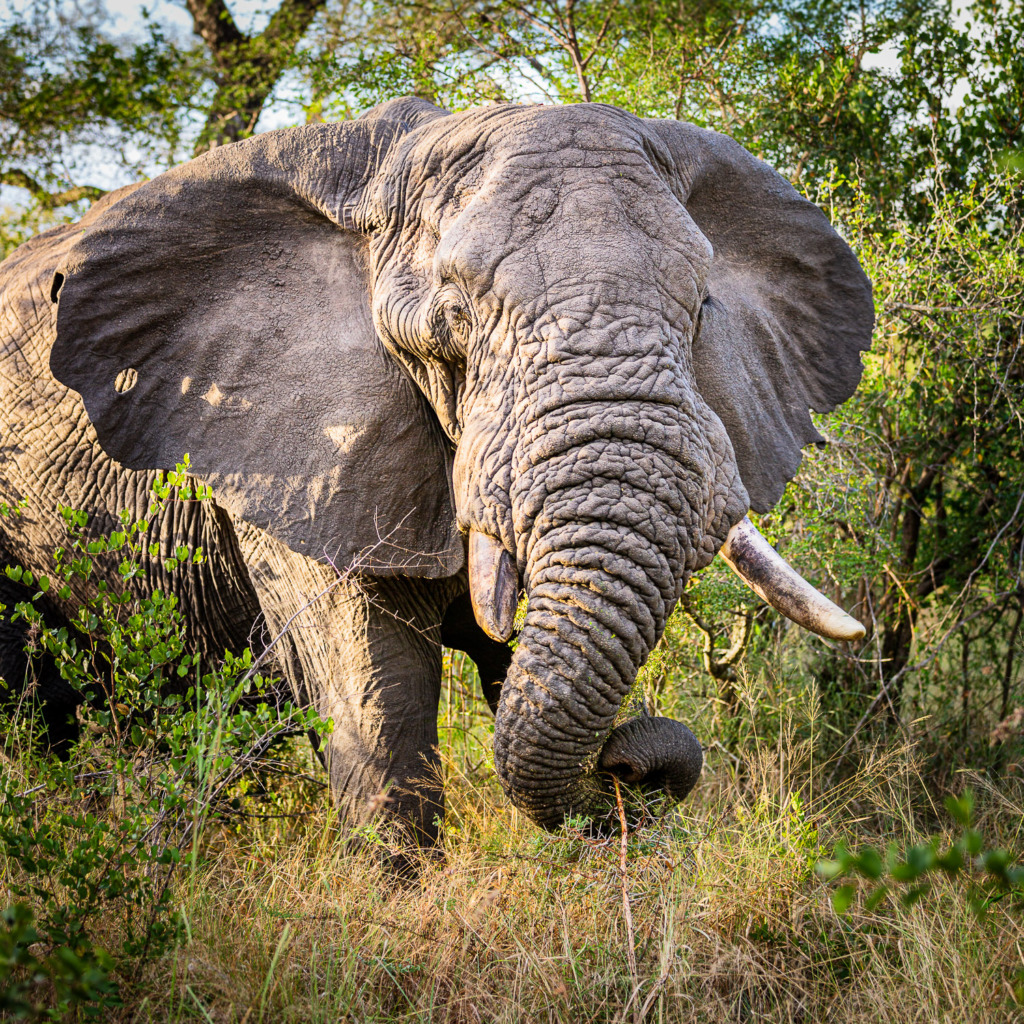
When to go
Spring has just started here in the northern hemisphere, but in South Africa, they’re heading into fall. Why would this be a good time to go? Winter is the low season, meaning that there are fewer visitors, perfect in our pandemic world. The prices may also be lower.
But even without COVID, Safari experts recommend May through September for a safari in South Africa. First of all, it’s the dry season, which means fewer mosquitos and more sun.
On top of that, the animal viewing is at its best. With less rain, there’s less foliage, and the animals congregate around the remaining water holes and rivers.
If you’ve seen photos of safaris in Kenya or Tanzania, you might wonder why I’m talking about vegetation. There’s a big difference in the terrain of these countries. The eastern part of South Africa, where the animals are concentrated, is a woodland savannah with thick and lush growth. That’s part of the romance of a safari in South Africa. You have to go out and search for the animals!
Kruger National Park
While Kruger National Park is famous for the Big Five (lion, leopard, rhinoceros, elephant, and Cape buffalo), seeing the wildlife can be challenging. Because off-road driving isn’t permitted, you are limited to what you can see from the park roads. However, this makes it a perfect place to go for a self-drive safari.
We fit our first safari in South Africa into a long weekend when Skip worked part-time in Cape Town. It was a spontaneous trip, with us staying at Buhala Lodge, along the Crocodile River’s southern banks, directly across from Kruger. We rented a small car (definitely not a safari vehicle! 😬) at the airport in Nelspruit and drove ourselves there. The lodge was lovely, with delicious food, fun games of Chinese Checkers in the bar before dinner, and incredible sunsets.
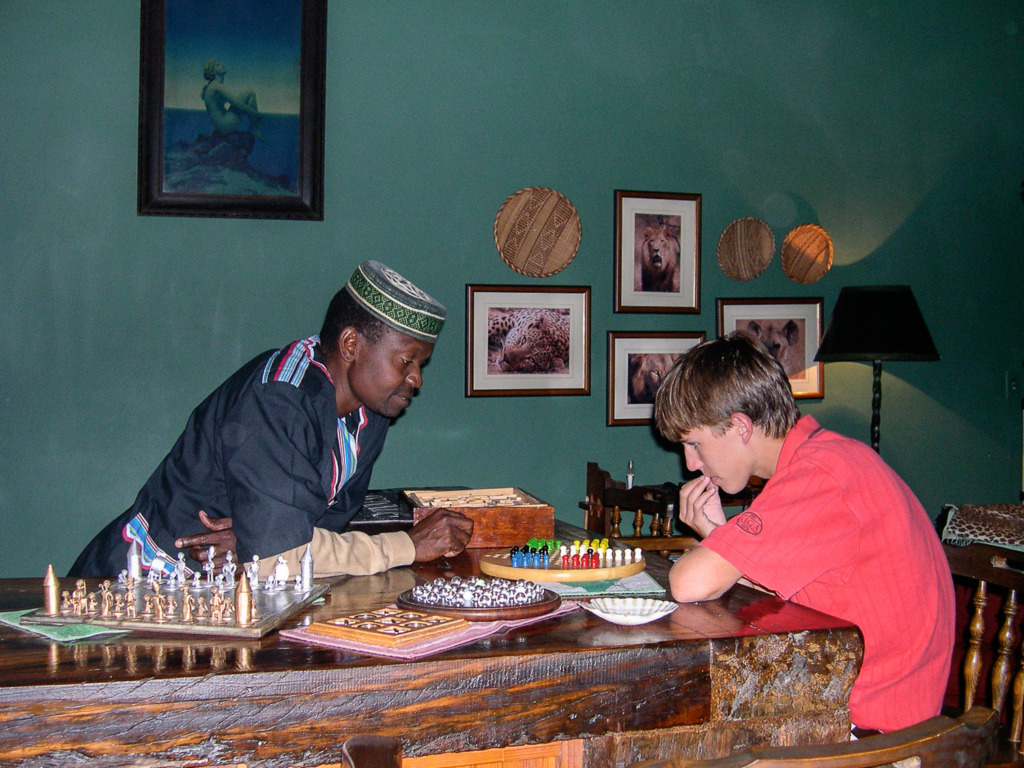
We had arranged for an all-day safari with a driver in a raised safari truck before we arrived, and it was well worth it. But a fun part of the weekend was driving ourselves around the park. Our 18-year-old son Andrew was with us, and he went on two drives by himself. (That’s him in the photo above, playing with Tookie, the bartender.)
For photographers, though, a self-drive safari can be a disappointment. I have many shots of the tail of a leopard sticking up through the tall grasses. Fortunately, the family in another car that had stopped to see the leopard took pity on us. They invited us to pull up right next to their specially outfitted four-wheel-drive truck, with a pop-up top. Then we crawled out of the window of our car and into theirs. Finally, we joined them, standing on the seats to look out of the open-top and see the animal. It helps to be a contortionist to pull this off! 🤣
Sabi Sabi
Nine years later, Skip was going on assignment to Cape Town again. This time, we planned and booked our safari in South Africa in advance. We stayed at Sabi Sabi, a private game reserve that shares an open border with Kruger. We divided our trip to stay at two of the camps there. Because of its private status, off-road driving was permitted if the tracking guide could tell that one of the Big Five was nearby.
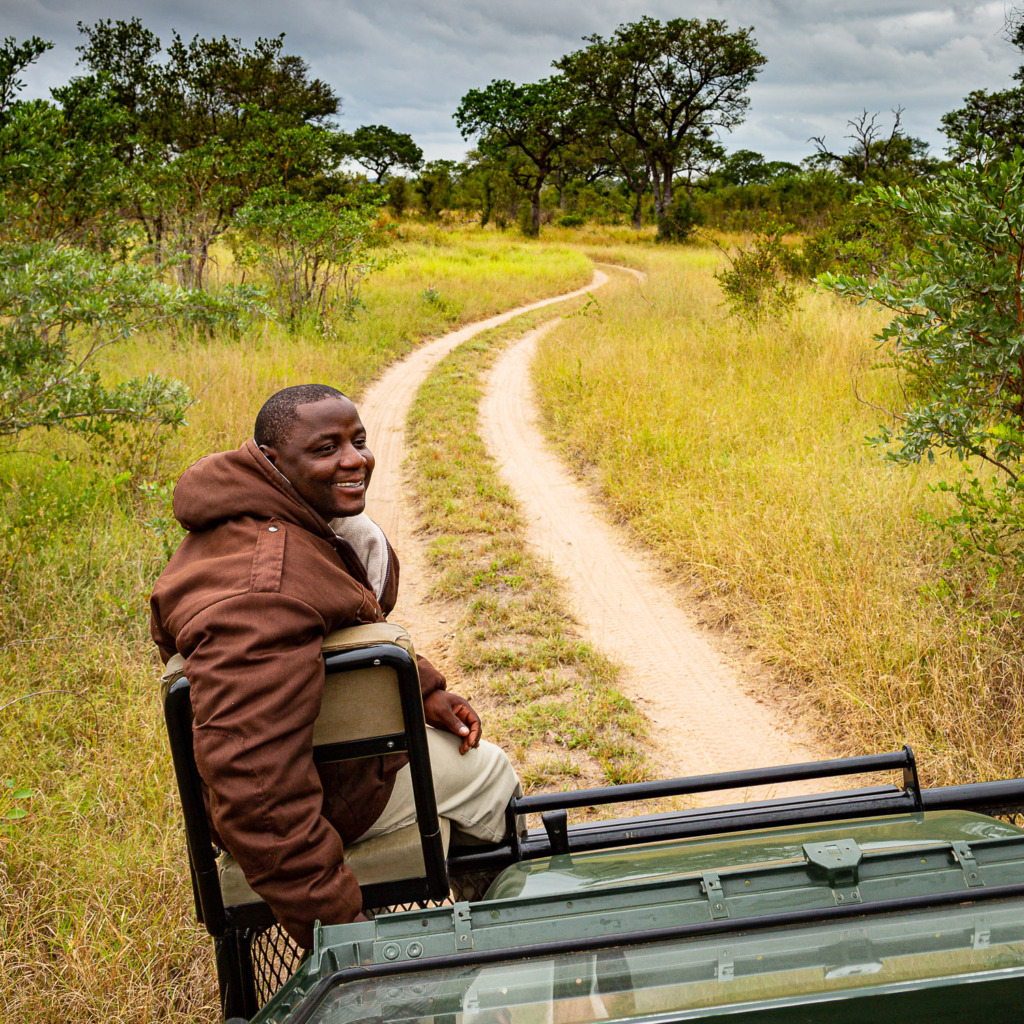
A stay at Sabi Sabi included two game drives each day. We rode in a raised open safari truck with a driver who was a game ranger, as well as a tracking guide sitting on a small seat above the front fender. (The photo at the very top is of one of the vehicles.) As we rode along, the driver would talk to us about the animals and their habits, while the tracker would watch for signs that animals were near. No two drives were alike.
Our rooms at the two camps were in detached luxury suites with thatch roofs. My only regret was that it was too cold to try out the private outdoor shower.
In the evening, a guard had to walk us to the main building for dinner since the camps were not enclosed in fencing. Sitting down to dinner while hearing the animals moving around was thrilling!
Choosing between a lodge and a camp
We’ve found we prefer camps. They are smaller and much less like hotels. At Sabi Sabi, we loved both the camps we chose: Little Bush and Selati. They will also be better choices if you are practicing social-distancing.
Tips for Travelers
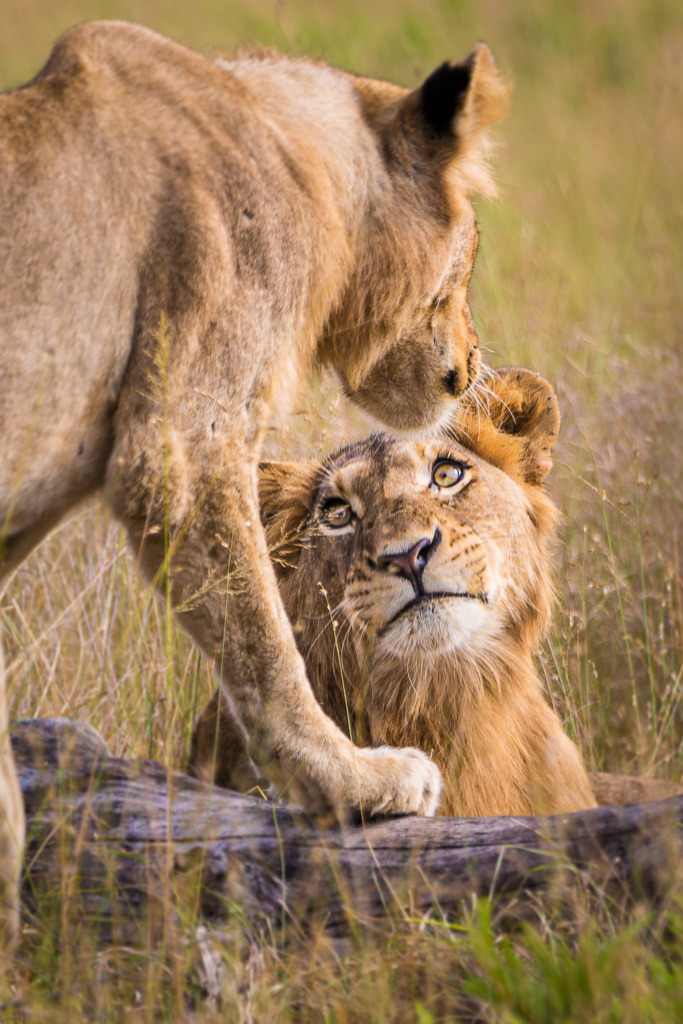
The animals are used to the shape of the safari vehicles, along with the sounds and smells. It’s important to stay seated. If you stand, you change the shape of the truck. And the animals do watch!
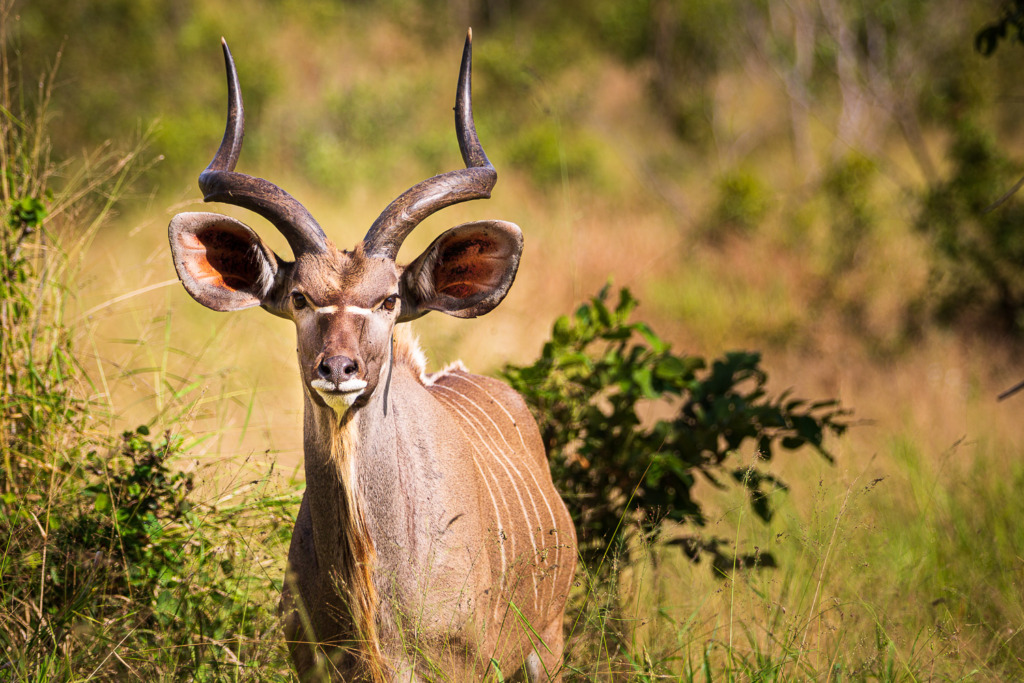
Don’t be “that person!” Leave your bright and colorful clothes and hats at home. There’s a reason for the dull tan safari clothes. You don’t disturb the animals, so you’ll get a much better viewing. Also, some bright colors attract flies, which is not a pleasant experience.
You don’t need much clothing when you go on safari in South Africa. Everywhere we stayed offered one-day laundry service. You may be flying to your camp in a small plane with a low luggage-weight limit! Save that weight for your camera gear 😎. However, you will need a warm jacket and hat for early-morning game drives.
Tips for Photographers
I brought a tripod on the safari but didn’t use it much. A monopod would have come in handy in the truck and weighed less. Your arms get tired holding up large lenses.
There are two solutions if you don’t own a long lens (400 mm or longer). You can buy an extender for your 200mm lens, which will double it to 400mm, or you can rent a larger lens for the trip.
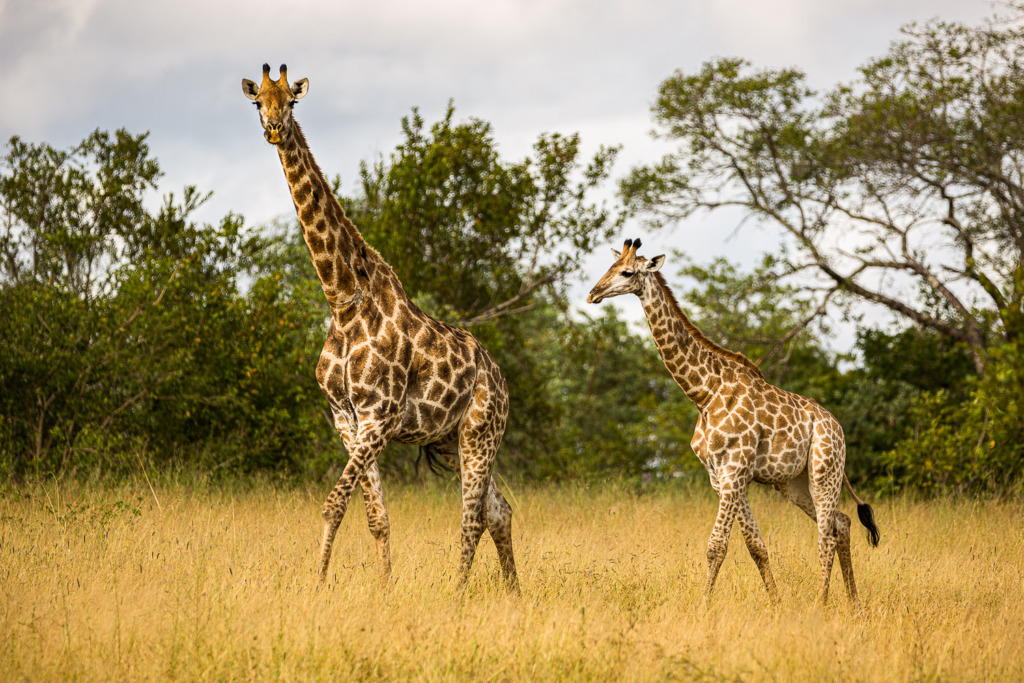
If you can, bring two camera bodies with lenses. One can be a wider zoom lens, like a 24-105mm. The other will be your long lens. Sometimes you’re busy shooting photos of an animal in the distance when suddenly you realize that a lion is crawling around the tires of your truck—that’s when having two lenses will come in handy!
Practice shooting in low light before you go. When you’re on safari in South Africa, you’ll find that the animals are most active right around sunrise and sunset, so you’ll be shooting most of your photos in low light.
If you’re unsure of shooting in modes other than auto, switch to Program mode. It’s essentially an auto mode, but your flash won’t fire. Then be sure to set your ISO to automatic.
Finally, practice choosing one focus point before you go. That will make all the difference in your photos. The animals are often partially hidden by rocks or foliage, and your camera will focus on whatever is closest unless you tell it not to.
Now it’s your turn
Are you interested in Sabi Sabi? Here’s a link to their website.
Wondering how to set your focus point? I’ve written about it here.
Don’t forget to leave a little room around your subject when you shoot. That will allow you to crop your photos for different frame sizes. You can read about it here.
Have you gone on a safari? Where was your favorite place? Please share in the comments.


Leave a reply